Comparative Analysis of Flood Prevention and Control at LID Facilities with Runoff and Flooding as Control Objectives Based on InfoWorks ICM
Abstract
:1. Introduction
2. Materials and Methodologies
2.1. Study Area
2.2. ICM Model
2.2.1. ICM Model Generalization
2.2.2. Parameter Calibration and Verification
2.2.3. Design Storms
2.3. Two Different Targets Setting Up LID Facilities
2.3.1. Targeting Runoff
2.3.2. Targeting Flooding
2.4. Cost of LID Facilities
2.5. Evaluation Index
3. Results
3.1. Comparison of Runoff Control Effect
3.2. Comparison of Flooding Control Effect
3.3. Comparison of Ponding Control Effect
4. Discussion
5. Conclusions
- This paper verifies the control effect of LID facilities on runoff, flooding, and ponding, which is better in a low return period than in a high return period and better in short durations than in long durations. With the increase in the return period, the soil gradually approaches saturation, which will gradually weaken the capacity of LID facilities.
- Under return periods of less than 5 a, FACO can fully utilize the capacity of LID facilities to reduce the waterlogged area. FACO and RACO have very small or even close to zero ponding areas at short–duration rainfall with a return period of less than 5 a and at long–duration rainfall with a return period of less than 3 a. However, the LID placement area of RACO is much larger than that of FACO. The extra area of LID facilities of RACO compared to FACO cannot utilize the capacity of LID facilities, which results in wastage.
- At return periods greater than 20 a, the deployment of LID facilities to alleviate flooding with FACO has no significant advantage over RACO. Under return periods of less than 20 a, the reduction of flooding per unit area through FACO is much larger than RACO, while at return periods greater than 20 a, the difference between FACO and RACO narrows down.
- FACO has a better economy for the mitigation of urban flooding. When the overflow volume of FACO and RACO is approximately the same, FACO can reduce the waste of LID facilities to a certain extent due to its deployment in the subcatchments upstream of the overflow point, and its deployment area and cost are lower than that of RACO.
- The deployment of LID facilities using FACO is suitable for return periods below 5 a, while LID facilities are often used as auxiliary measures. Therefore, for return periods exceeding 5 years, engineering measures such as network renovation and pump station construction should be adopted to alleviate urban flooding. This study only selects the central urban area of Beijing as the research area. The application of FACO to different urban areas to analyze the methodology more comprehensively is subject to further research. The proposed FACO deployment method has shown better results compared to RACO, but it may not be the optimal solution. The combination of FACO and optimization algorithms requires further research.
Author Contributions
Funding
Data Availability Statement
Conflicts of Interest
Abbreviations
| FACO | flooding as the control objective |
| RACO | runoff as the control objective |
| LID | low impact development |
| Short–duration | rainfall of short duration (180 min) |
| Long–duration | rainfall of long duration (1440 min) |
| SWMM | storm water management model |
| ICM | integrated catchment management |
| NSE | nash–sutcliffe efficiency |
| RMSE | root mean square error |
| PBIAS | percentage bias |
References
- Eckart, K.; McPhee, Z.; Bolisetti, T. Performance and implementation of low impact development—A review. Sci. Total Environ. 2017, 607–608, 413–432. [Google Scholar] [CrossRef] [PubMed]
- Li, Q.Y.; Yang, Y.C.; Liao, H.X.; Liu, M.Q.; Liao, L.P.; Huang, S.Q.; Sun, G.K.; Mo, C.X.; Li, X.G. The simulation, regulation capacity assessment and coping strategy of rainstorm runoff waterlogging in Zhu pai–chong Basin of Nanning, China. J. Environ. Manag. 2023, 332, 117395. [Google Scholar] [CrossRef] [PubMed]
- Liu, T.Q.; Lawluvy, Y.; Shi, Y.; Yap, P.S. Low impact development (LID) practices: A review on recent developments, challenges and prospects. Water Air Soil Pollut. 2021, 232, 344. [Google Scholar] [CrossRef]
- Muttil, N.; Nasrin, T.; Sharma, A.K. Impacts of extreme rainfalls on sewer overflows and WSUD–based mitigation strategies: A review. Water 2023, 15, 429. [Google Scholar] [CrossRef]
- Newcomer, M.E.; Gurdak, J.J.; Sklar, L.S.; Nanus, L. Urban recharge beneath low impact development and effects of climate variability and change. Water Resour. Res. 2014, 50, 1716–1734. [Google Scholar] [CrossRef]
- Gilroy, K.L.; McCuen, R.H. Spatio–temporal effects of low impact development practices. J. Hydrol. 2009, 367, 228–236. [Google Scholar] [CrossRef]
- Guo, J.C.Y. Preservation of watershed regime for low–impact development through detention. J. Hydrol. Eng. 2010, 15, 15–19. [Google Scholar] [CrossRef]
- Aguayo, M.; Yu, Z.W.; Piasecki, M.; Montalto, F. Development of a web application for low impact development rapid assessment (LIDRA). J. Hydroinform. 2013, 15, 1276–1295. [Google Scholar] [CrossRef]
- Joksimovic, D.; Alam, Z. Cost efficiency of low impact development (LID) stormwater management practices. Procedia Eng. 2014, 89, 734–741. [Google Scholar] [CrossRef]
- Bhaskar, A.S.; Hogan, D.M.; Archfield, S.A. Urban base flow with low impact development. Hydrol. Process. 2016, 30, 3156–3171. [Google Scholar] [CrossRef]
- Leimgruber, J.; Krebs, G.; Camhy, D.; Muschalla, D. Sensitivity of model–based water balance to low impact development parameters. Water 2018, 10, 1838. [Google Scholar] [CrossRef]
- Eckart, K.; McPhee, Z.; Bolisetti, T. Multiobjective optimization of low impact development stormwater controls. J. Hydrol. 2018, 562, 564–576. [Google Scholar] [CrossRef]
- Liu, Y.Z.; Bralts, V.F.; Engel, B.A. Evaluating the effectiveness of management practices on hydrology and water quality at watershed scale with a rainfall–runoff model. Sci. Total Environ. 2015, 511, 298–308. [Google Scholar] [CrossRef] [PubMed]
- Wang, M.; Zhang, D.Q.; Adhityan, A.; Ng, W.J.; Dong, J.W.; Tan, S.K. Assessing cost–effectiveness of bioretention on stormwater in response to climate change and urbanization for future scenarios. J. Hydrol. 2016, 543, 423–432. [Google Scholar] [CrossRef]
- Jemberie, M.A.; Melesse, A.M. Urban flood management through urban land use optimization using LID techniques, city of Addis Ababa, Ethiopia. Water 2021, 13, 1721. [Google Scholar] [CrossRef]
- Li, F.; Yan, X.F.; Duan, H.F. Sustainable design of urban stormwater drainage systems by implementing detention tank and LID measures for flooding risk control and water quality management. Water Resour. Manag. 2019, 33, 3271–3288. [Google Scholar] [CrossRef]
- Tansar, H.; Duan, H.F.; Mark, O. Catchment–scale and local–scale based evaluation of LID effectiveness on urban drainage system performance. Water Resour. Manag. 2022, 36, 507–526. [Google Scholar] [CrossRef]
- Suresh, A.; Pekkat, S.; Subbiah, S. Quantifying the efficacy of low impact developments (LIDs) for flood reduction in micro–urban watersheds incorporating climate change. Sustain. Cities Soc. 2023, 95, 104601. [Google Scholar] [CrossRef]
- Sin, J.; Jun, C.; Zhu, J.H.; Yoo, C. Evaluation of flood runoff reduction effect of LID (Low Impact Development) based on the decrease in CN: Case studies from Gimcheon Pyeonghwa district, Korea. Procedia Eng. 2014, 70, 1531–1538. [Google Scholar] [CrossRef]
- Luan, Q.H.; Fu, X.R.; Song, C.P.; Wang, H.C.; Liu, J.H.; Wang, Y. Runoff effect evaluation of LID through SWMM in typical mountainous, low–lying urban areas: A case study in China. Water 2017, 9, 439. [Google Scholar] [CrossRef]
- Dos Santos, M.F.N.; Barbassa, A.P.; Vasconcelos, A.F.; Ometto, A.R. Stormwater management for highly urbanized areas in the tropics: Life cycle assessment of low impact development practices. J. Hydrol. 2021, 598, 126409. [Google Scholar] [CrossRef]
- Kumar, S.; Guntu, R.K.; Agarwal, A.; Villuri, V.G.K.; Pasupuleti, S.; Kaushal, D.R.; Gosian, A.K.; Bronstert, A. Multi–objective optimization for stormwater management by green–roofs and infiltration trenches to reduce urban flooding in central Delhi. J. Hydrol. 2022, 606. [Google Scholar] [CrossRef]
- Yang, B.Y.; Zhang, T.; Li, J.Z.; Feng, P.; Miao, Y.J.J. Optimal designs of LID based on LID experiments and SWMM for a small–scale community in Tianjin, north China. J. Environ. Manag. 2023, 334, 117442. [Google Scholar] [CrossRef] [PubMed]
- Ferguson, C.; Fenner, R. The impact of natural flood management on the performance of surface drainage systems: A case study in the Calder Valley. J. Hydrol. 2020, 590, 125354. [Google Scholar] [CrossRef]
- Cheng, T.; Xu, Z.X.; Hong, S.Y.; Song, S.L. Flood risk zoning by using 2D hydrodynamic modeling: A case study in Jinan city. Math. Probl. Eng. 2017, 2017, 5659197. [Google Scholar] [CrossRef]
- Zhou, J.J.; Pang, Y.L.; Wang, H.; Li, W.T.; Liu, J.H.; Luo, Z.R.; Shao, W.W.; Zhang, H.J. Sewage network operational risks based on InfoWorks ICM with nodal flow diurnal patterns under NPIs for COVID-19. Water Res. 2023, 246, 120708. [Google Scholar] [CrossRef] [PubMed]
- DB11/T 2074–2022; Technical Specification for Construction and Application of Mathematical Model of Urban Flooding Prevention and Control System. Beijing Municipal Commission of Planning and Natural Resources, Beijing Municipal Bureau of Market Supervision and Administration: Beijing, China, 2022.
- Xu, W.B.; Jiang, Z.Q.; Yuan, Y.; Zhai, M.M.; Li, N.; Gao, J.Y.; Li, J.K. Analysis of urban waterlogging and LID reconstruction scheme in Nanchang City based on MIKE & SWMM. Water Resour. Power 2023, 41, 77–81+171. [Google Scholar]
- Hua, P.; Yang, W.Y.; Qi, X.C.; Jiang, S.S.; Xie, J.Q.; Gu, X.Y.; Li, H.H.; Zhang, J.; Krebs, P. Evaluating the effect of urban flooding reduction strategies in response to design rainfall and low impact development. J. Clean Prod. 2020, 242, 118515. [Google Scholar] [CrossRef]
- Koc, K.; Ekmekcioglu, O.; Ozger, M. An integrated framework for the comprehensive evaluation of low impact development strategies. J. Environ. Manag. 2021, 294, 113023. [Google Scholar] [CrossRef]
- Wang, H.; Zhou, J.J.; Tang, Y.; Liu, Z.L.; Kang, A.Q.; Chen, B. Flood economic assessment of structural measure based on integrated flood risk management: A case study in Beijing. J. Environ. Manag. 2021, 280, 111701. [Google Scholar] [CrossRef]
- Wang, J.; Liu, J.H.; Yang, Z.X.; Mei, C.; Wang, H.; Zhang, D.Q. Green infrastructure optimization considering spatial functional zoning in urban stormwater management. J. Environ. Manag. 2023, 344, 118407. [Google Scholar] [CrossRef] [PubMed]

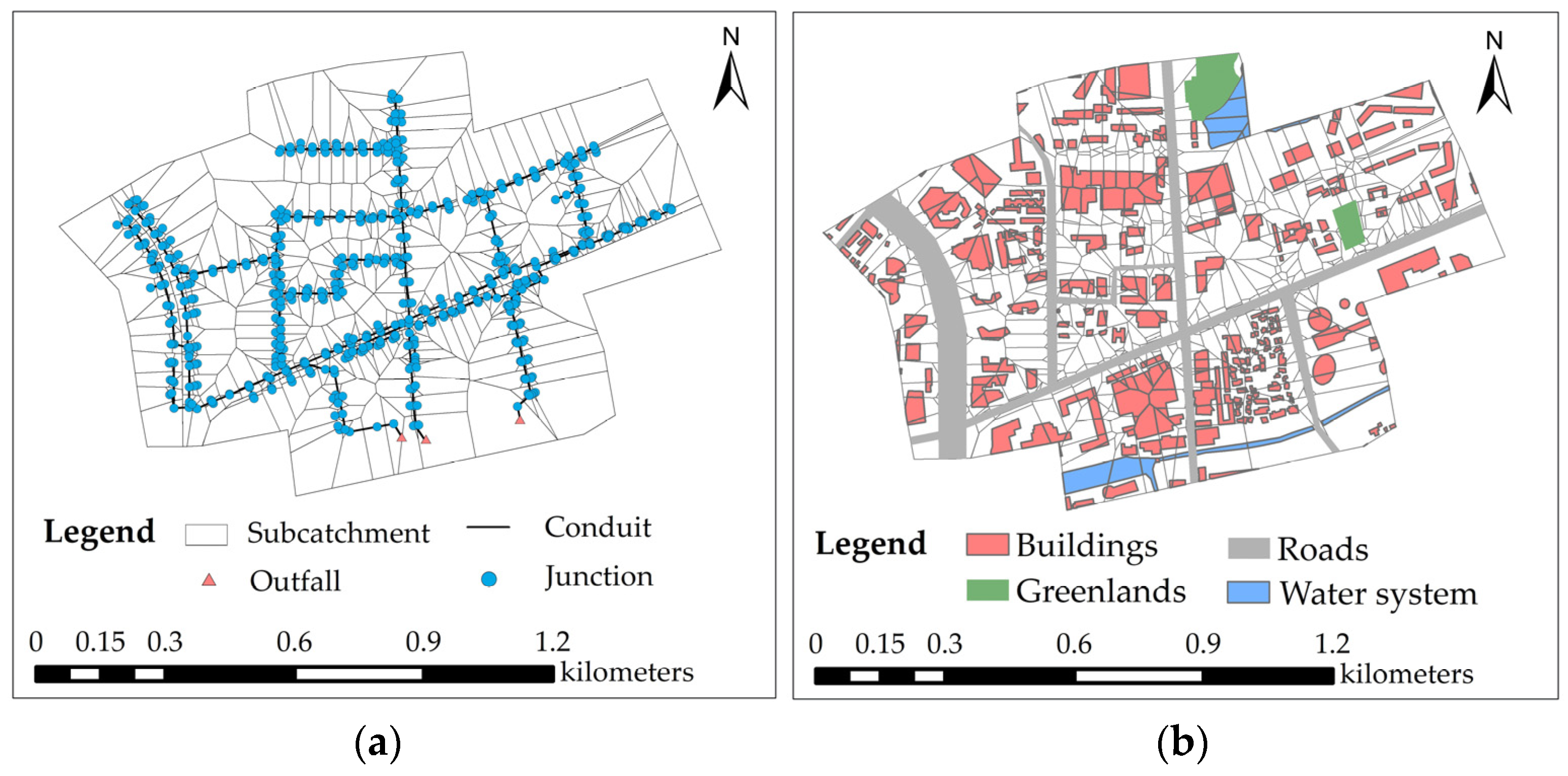



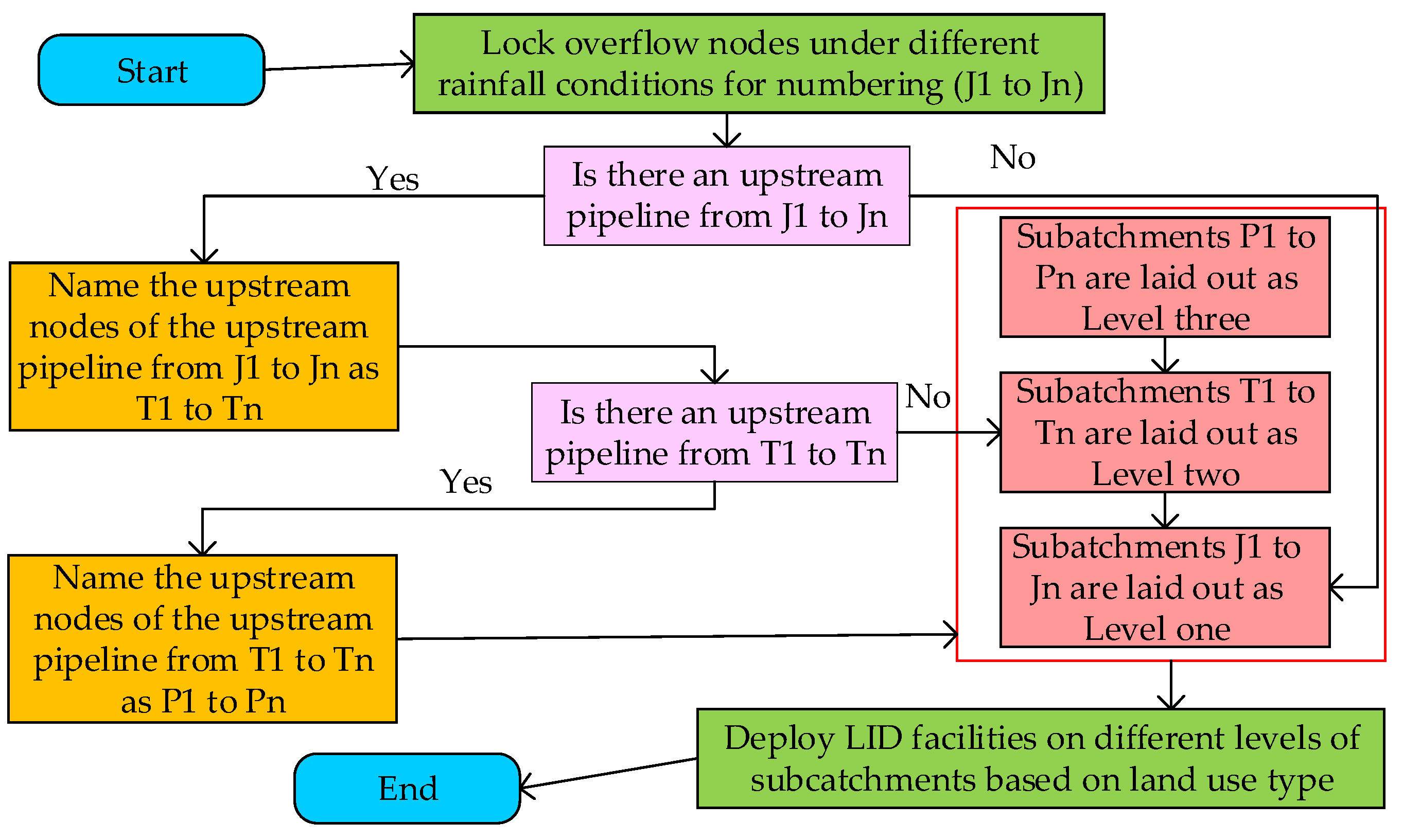
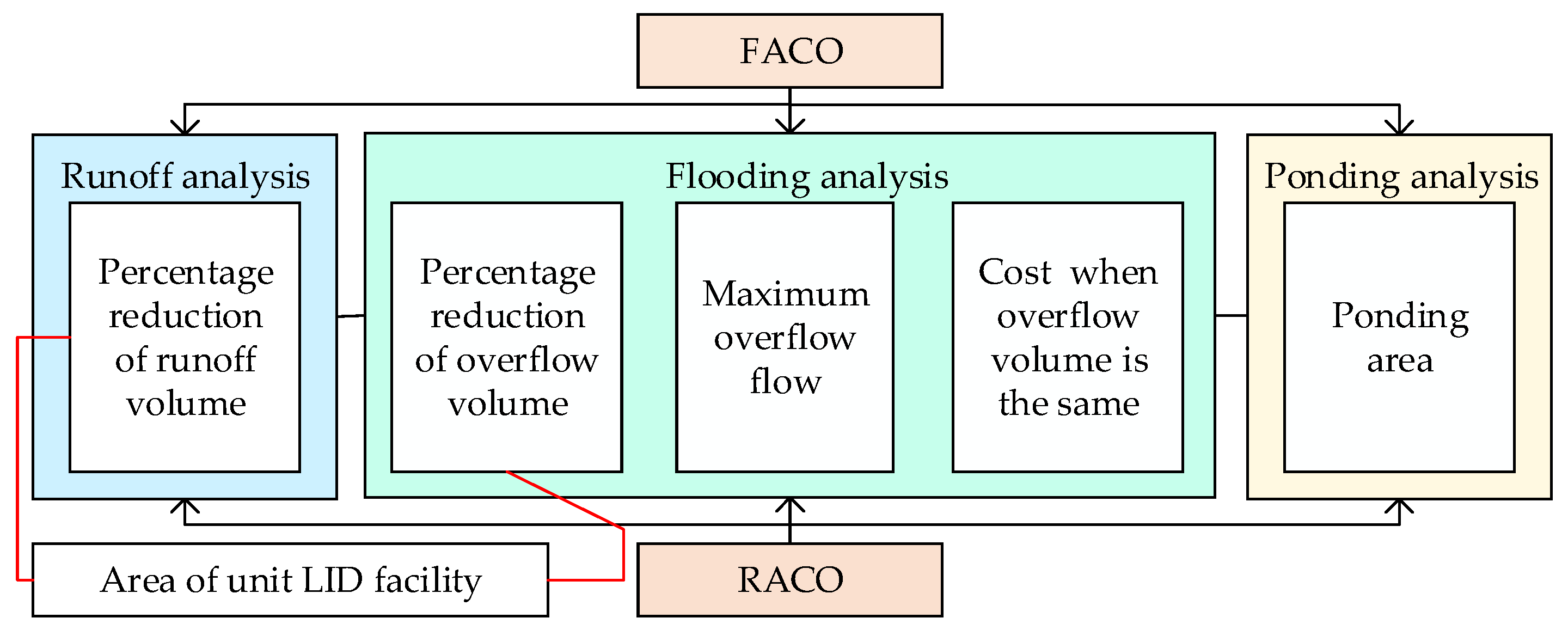




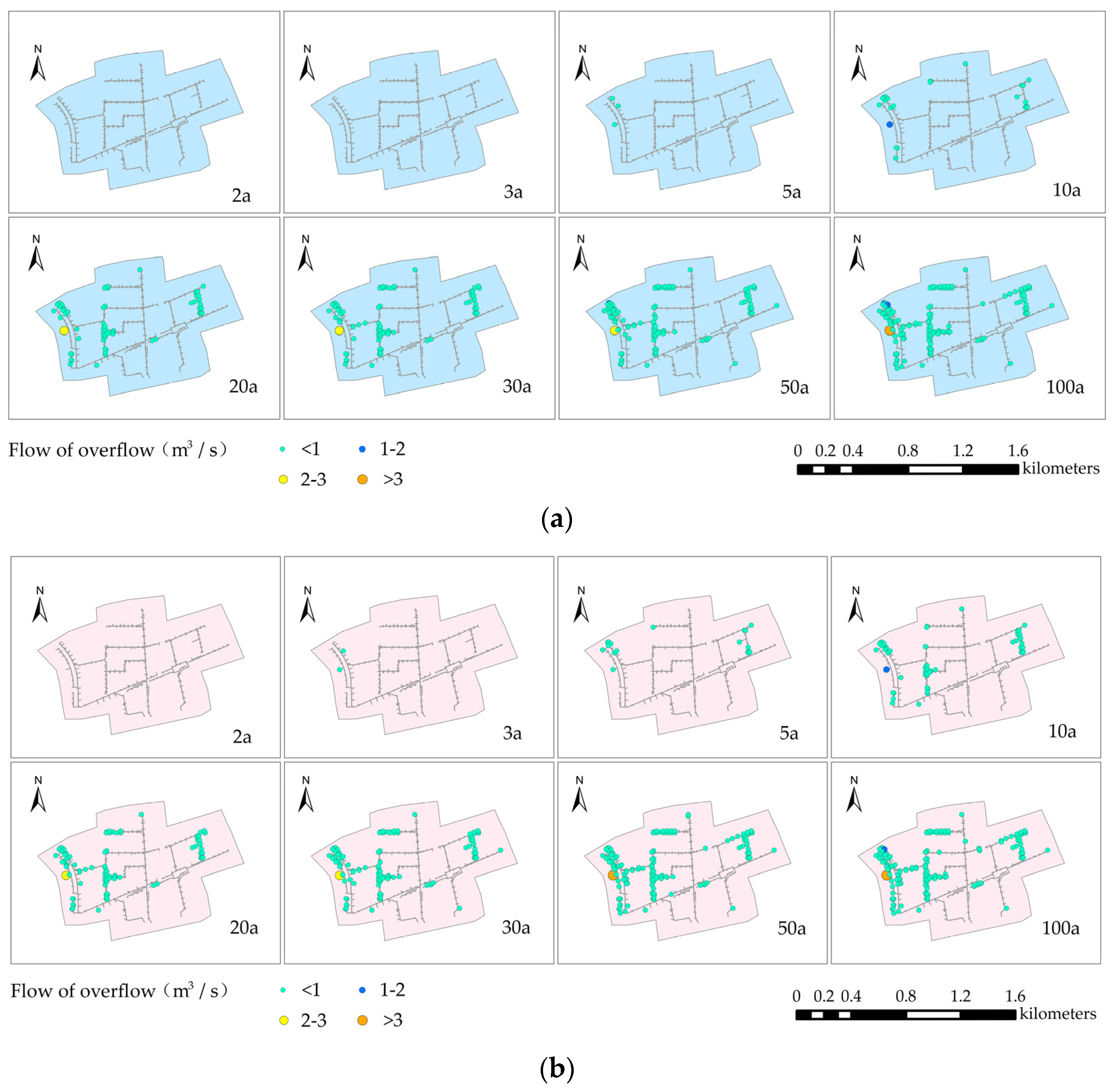

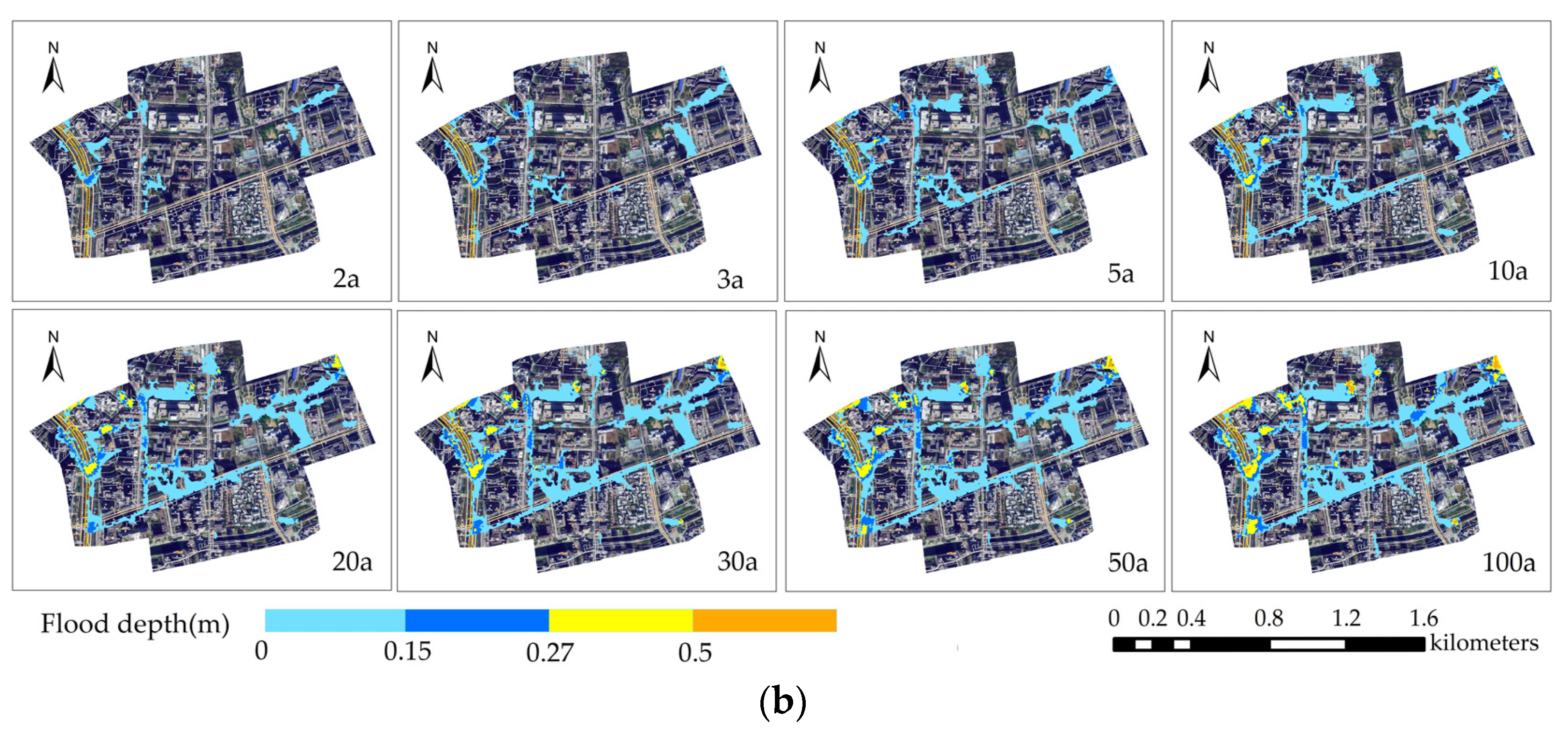

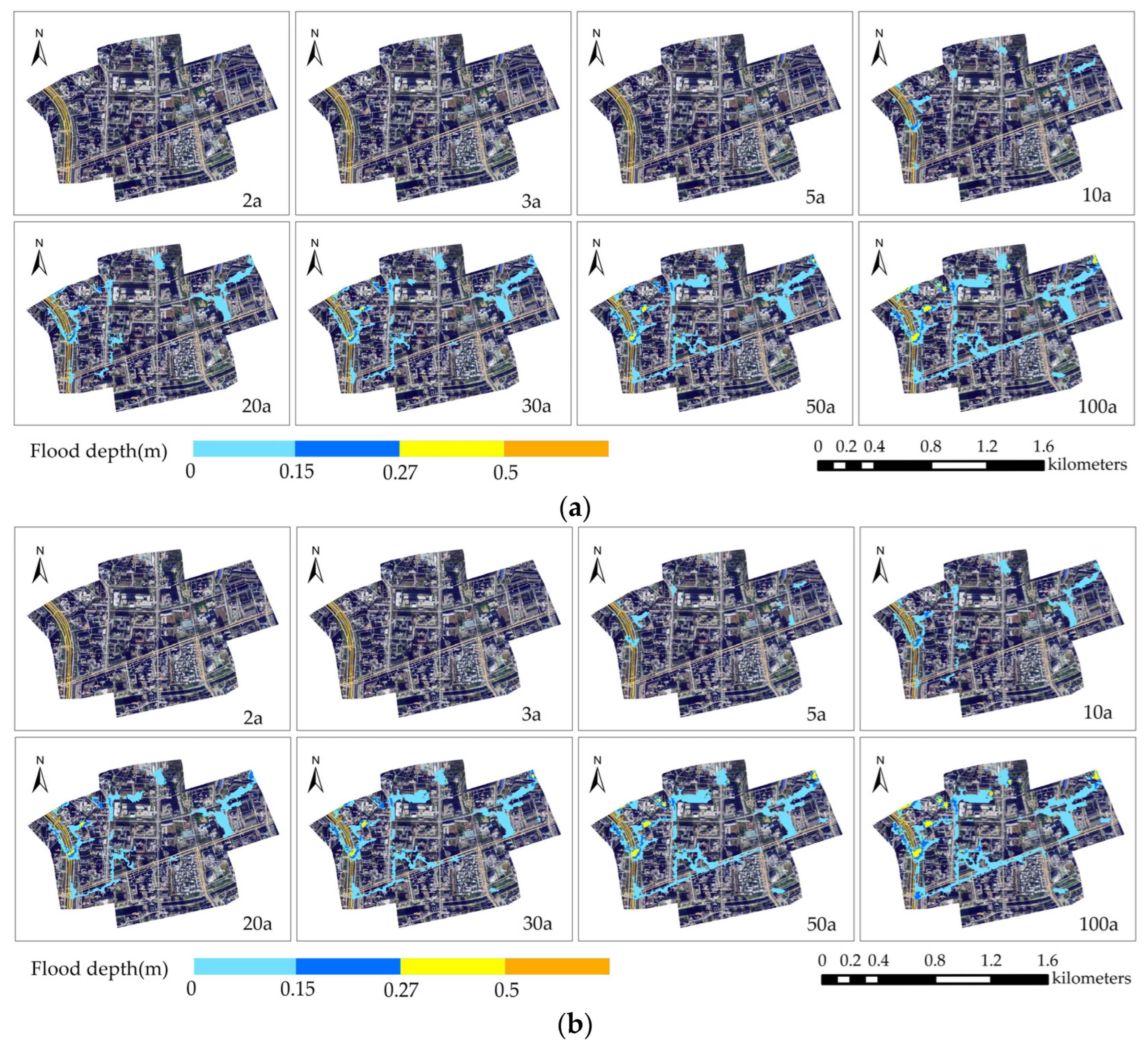

| Evaluation Metrics | NSE | RMSE | PBIAS |
|---|---|---|---|
| J155 for 21 August 2022 | 0.938 | 0.077 | −0.024 |
| J280 for 21 August 2022 | 0.901 | 0.071 | −0.073 |
| J155 for 3 September 2022 | 0.927 | 0.010 | 0.040 |
| J280 for 3 September 2022 | 0.902 | 0.008 | −0.040 |
| Return Period | 2a | 3a | 5a | 10a | 20a | 30a | 50a | 100a |
|---|---|---|---|---|---|---|---|---|
| Short–duration | 63.35 | 72.17 | 83.28 | 98.35 | 113.20 | 122.00 | 133.08 | 148.12 |
| Long–duration | 127.36 | 145.06 | 167.53 | 197.72 | 228.06 | 245.68 | 268.19 | 298.46 |
| Process Layer | Parameter | Rain Garden | Green Roof | Permeable Pavement |
|---|---|---|---|---|
| Surface layer | Berm Height/mm | 250.00 | 50.00 | 0.00 |
| Vegetation Volume | 0.10 | 0.60 | 0.00 | |
| Surface Roughness | 0.24 | 0.80 | 0.01 | |
| Surface Slope/% | 5.00 | 0.20 | 0.50 | |
| Soil layer | Thickness/mm | 900.00 | 100.00 | 150.00 |
| Porosity | 0.18 | 0.18 | 0.50 | |
| Field Capacity | 0.10 | 0.10 | 0.20 | |
| Wilting Point | 0.03 | 0.03 | 0.00 | |
| Conductivity/(mm·h−1) | 18.00 | 18.00 | 720.00 | |
| Conductivity Slope | 10.00 | 10.00 | 10.00 | |
| Suction Head/mm | 90.00 | 90.00 | 90.00 | |
| Storage layer | Thickness/mm | 0.00 | — | 600.00 |
| Void Ratio | 0.75 | — | 0.75 | |
| Seepage Rate/(mm·h−1) | 12.70 | — | 12.70 | |
| Clogging Factor | 0.00 | — | 180.00 |
| Duration of Rainfall | Return Period | Rain Garden (ha) | Green Roof (ha) | Permeable Pavement (ha) | Total Area (ha) |
|---|---|---|---|---|---|
| Short– duration | 2 a | 1.29 | 4.05 | 1.39 | 6.74 |
| 3 a | 1.32 | 5.25 | 1.88 | 8.44 | |
| 5 a | 1.59 | 6.87 | 2.52 | 10.99 | |
| 10 a | 3.20 | 10.75 | 3.75 | 17.70 | |
| 20 a | 6.38 | 14.35 | 5.33 | 26.06 | |
| 30 a | 6.62 | 15.81 | 6.35 | 28.78 | |
| 50 a | 7.19 | 16.65 | 7.29 | 31.12 | |
| 100 a | 7.20 | 17.62 | 7.81 | 32.63 | |
| Long– duration | 2 a | 1.42 | 5.18 | 1.85 | 8.45 |
| 3 a | 1.81 | 6.04 | 2.13 | 9.98 | |
| 5 a | 2.07 | 9.02 | 3.64 | 14.73 | |
| 10 a | 5.30 | 13.30 | 4.81 | 23.41 | |
| 20 a | 6.64 | 15.31 | 5.78 | 27.74 | |
| 30 a | 6.86 | 16.02 | 6.38 | 29.25 | |
| 50 a | 7.06 | 17.02 | 7.09 | 31.16 | |
| 100 a | 7.18 | 17.90 | 8.54 | 33.62 |
| LID Facility | Unit Infrastructure Cost (Yuan·m−2) | Unit Maintenance Cost (Yuan·m−2·a−1) |
|---|---|---|
| Rain Garden | 800 | 55 |
| Green Roof | 200 | 6 |
| Permeable Pavement | 780 | 8.7 |
| Return Period | FACO–Short (Yuan) | RACO–Short (Yuan) | FACO–Long (Yuan) | RACO–Long (Yuan) |
|---|---|---|---|---|
| 2 a | 6.15 × 107 | 6.61 × 107 | 7.37 × 107 | 1.37 × 108 |
| 3 a | 7.18 × 107 | 8.99 × 107 | 8.94 × 107 | 1.48 × 108 |
| 5 a | 9.14 × 107 | 1.37 × 108 | 1.23 × 108 | 1.74 × 108 |
| 10 a | 1.58 × 108 | 2.43 × 108 | 2.31 × 108 | 2.43 × 108 |
| 20 a | 2.66 × 108 | 3.12 × 108 | 2.81 × 108 | 3.07 × 108 |
| 30 a | 2.88 × 108 | 3.60 × 108 | 2.95 × 108 | 3.70 × 108 |
| 50 a | 3.15 × 108 | 3.97 × 108 | 3.11 × 108 | 4.07 × 108 |
| 100 a | 3.25 × 108 | 4.23 × 108 | 3.33 × 108 | 4.23 × 108 |
Disclaimer/Publisher’s Note: The statements, opinions and data contained in all publications are solely those of the individual author(s) and contributor(s) and not of MDPI and/or the editor(s). MDPI and/or the editor(s) disclaim responsibility for any injury to people or property resulting from any ideas, methods, instructions or products referred to in the content. |
© 2024 by the authors. Licensee MDPI, Basel, Switzerland. This article is an open access article distributed under the terms and conditions of the Creative Commons Attribution (CC BY) license (https://creativecommons.org/licenses/by/4.0/).
Share and Cite
Cheng, X.; Wang, H.; Chen, B.; Li, Z.; Zhou, J. Comparative Analysis of Flood Prevention and Control at LID Facilities with Runoff and Flooding as Control Objectives Based on InfoWorks ICM. Water 2024, 16, 374. https://doi.org/10.3390/w16030374
Cheng X, Wang H, Chen B, Li Z, Zhou J. Comparative Analysis of Flood Prevention and Control at LID Facilities with Runoff and Flooding as Control Objectives Based on InfoWorks ICM. Water. 2024; 16(3):374. https://doi.org/10.3390/w16030374
Chicago/Turabian StyleCheng, Xinyue, Hao Wang, Bin Chen, Zhi Li, and Jinjun Zhou. 2024. "Comparative Analysis of Flood Prevention and Control at LID Facilities with Runoff and Flooding as Control Objectives Based on InfoWorks ICM" Water 16, no. 3: 374. https://doi.org/10.3390/w16030374






